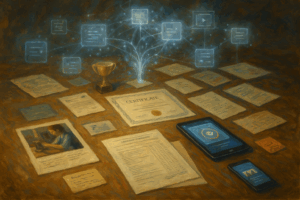How Do Stories Work in TalentPass?
A Tree-Based Explanation of How Your Talent Becomes Structured and Connected**
TalentPass helps you capture your experiences — but what the system actually builds for you is something deeper and more powerful:
stories.
Stories are the way TalentPass expresses your talent in a clear, structured, and portable form.
They’re not just memories.
They’re not essays.
And they’re definitely not limited to job tasks or responsibilities.
Stories in TalentPass come from your Talent Tree — a framework that represents every dimension of human talent in 13 interconnected parts.
This FAQ explains how stories are created, where they come from, and why they matter.
The Talent Tree: The Foundation of All Stories
TalentPass organizes your talent using a structure called the Talent Tree, with 13 major nodes:
- Agency
- Motivations
- Identity
- Interests
- Roles
- Activities
- Voice
- Technical Skills
- Human Skills
- Wisdom
- Intelligence
- Creativity
- Potential
Each node has sub-branches.
Each sub-branch represents a more specific aspect of who you are or what you can do.
These nodes reflect the layers of real human capability — from the concrete (roles, activities, skills) to the abstract (identity, intelligence, motivations, creativity, wisdom, potential).
Stories live on these branches.
Each story connects to one or more nodes.
What Is a Story?
A story is:
A structured expression of something true about your talent — placed on the Talent Tree.
Stories can represent:
1. A single experience
A clear moment from work, school, home, or community life.
2. A skill expression
A recurring way you show a technical or human skill.
3. A motivational pattern
Something that consistently drives your choices.
4. An identity-based insight
A way you show up, make decisions, or relate to others.
5. A creative or intelligent behavior pattern
How you approach complex or novel problems.
6. A cluster of related moments (a gallery story)
Several experiences that together reveal a theme or strength.
7. A potential or growth-based observation
An emerging capability shaped by multiple inputs.
In TalentPass, all of these are stories.
Not just the things you did — but the patterns behind them.
How Stories Are Formed from Your Entries
When you add:
- an experience
- a role
- an activity
- evidence
- a responsibility
- a challenge
- an achievement
TalentPass places that “physical” information onto certain parts of the tree:
- Roles node
- Activities node
- Contributions/Outcomes node
- Skills nodes
- Interests
- Motivations
- Agency
- Identity
- and sometimes Creativity, Intelligence, or Wisdom
Then, the system looks at:
- what happened
- how it happened
- what it connected to
- which skills you used
- what motivated you
- what patterns show up
- what evidence supports it
From that, TalentPass creates stories.
Some stories come from specific events.
Others emerge as patterns across multiple events.
Some come from your motivations or behaviors.
Others come from your style of thinking or communicating.
Every part of the Talent Tree contributes.
Stories Are “Hung” on the Scaffolding of the Tree
Each story is placed on one or more nodes.
Examples:
A story on Human Skills:
Demonstrating teamwork, empathy, conflict resolution.
A story on Technical Skills:
Using Excel, repairing equipment, coding, operating tools.
A story on Identity:
Realizing you take initiative or advocate for others.
A story on Intelligence:
Breaking down complex problems or thinking analytically.
A story on Creativity:
Inventing solutions, improvising, designing something new.
A story on Motivations:
What drives you to act, support others, or pursue goals.
A story on Agency:
Taking responsibility, making decisions, stepping up.
A story on Potential:
Patterns that show growth or future capabilities.
Stories don’t sit in a folder — they live in the tree, where they connect to other stories, skills, and experiences.
This interconnectedness is what makes them meaningful.
Why Connections Matter More Than Individual Moments
A single story is informative.
But connected stories reveal:
- patterns
- strengths
- emerging abilities
- consistency
- growth
- authenticity
- depth
- real-world capability
TalentPass tracks:
- the links between nodes
- the order in which stories appear
- the skills activated
- the motivations or agency expressed
- the creative or intelligent behaviors shown
- the evidence attached
- the context (school, work, life)
This is what makes your Talent Tree come alive.
Where Stories Appear in TalentPass
Stories surface in several places:
1. Your Profile
Your profile shows selected stories that represent your abilities.
2. Your Resume
Stories become the building blocks of your resume content.
3. Tailored Job Applications
When you tailor a resume for a specific job, TalentPass selects the stories that match the role.
4. Upcoming Passport Pages
Organizations will be able to view verified stories that relate to their services, support, or decision process.
5. Your Talent Tree View (Coming Soon)
As the Talent Tree becomes more visible, you’ll see how your stories sit on branches and connect to each other.
On the Backend: Stories Are Structured LERs
You don’t have to think about this — but behind the scenes:
- every story is a Learning and Employment Record (LER)
- it’s formatted
- portable
- interoperable
- ready for verification
- evidence-supported when possible
This is what makes TalentPass more powerful than a resume platform — it’s building portable, structured talent data.
Final Takeaway
Stories in TalentPass are much more than descriptions of what you’ve done.
They are:
- expressions of your abilities
- reflections of your identity and motivations
- summaries of your skills
- insights into your intelligence and creativity
- patterns of your growth and potential
- connected nodes in your Talent Tree
- portable, structured records of your talent
They come from every layer of your life — from experiences to behaviors to deep aspects of who you are.
Stories are how TalentPass communicates your talent to the world.





